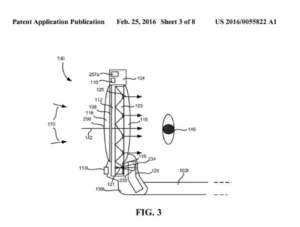In a brand new patent application, Microsoft claims a technology that would create a head-mounted display that is capable of acting as AR and VR glasses. The patent (US patent application 2015/045779), titled ‘Head-Mounted Display with Electrochromic Dimming Module for Augmented and Virtual Reality Perception‘, adds an extra layer in the near-eye device to allow the headset to function either as an augmented reality set or as a virtual reality set, depending on the content.

The added layer is an electrochromic cell that can be dimmed to control the amount of light going through the lens. If the cell is open the device acts as an AR device, and when the cell is closed you have a VR device. As a matter of fact, this kind of technology can also mix both types in one headset, if the light filter is based on a pixelated display that enables only the area where the headset is actually showing some content to be dimmed.
Source: Microsoft Patent Application US 2016-0055822
When we think of the actual performance of these devices we see two approaches:
- If we have an AR device, content is overlaid on the real world image, where light is coming through the optical combiner at all times and reaching our eyes in pretty much the same way as sunglasses work. If the AR device overlays content on a bright area of the real world, the resulting image will have very low contrast and the AR content is washed out or even not visible at all. In this case, the Microsoft patent would improve the AR performance by lowering the amount of light coming from the real world. In the extreme we could look into the sun and augmented reality could visualise someone sitting on it! Of course, that would be most likely outside of the dimming range of the electrochromic cell, but you get the idea.
- If we have a VR device, real world images can only come from a camera capturing the real world and playing it back for us in combination with the VR content. This is how the VR games in real environments work today. This limits the field of view to that of the camera or the VR display, both of which are typically smaller than what our human vision system provides. In this case the headset could allow some of the surrounding light coming through the optical combiner, creating some kind of hybrid AR/VR device.
Such a technical solution could do even better if the electrochromic cell would not just be a one-pixel light valve but a greyscale high resolution display. This would allow the user to see virtual content in full contrast within an augmented reality setting. Let’s say you look through such glasses; you may see a non-existent tutor standing in front of a real world object, explaining what is right in front of you. This virtual tutor would appear very natural as the VR engine could create the shading to match the lighting conditions in the real world at that particular time and location. This would be AR/VR with a realistic touch. Of course we are talking about science fiction here already. However, how far is this out if Microsoft has already filed a patent on part of this technology? – NH

